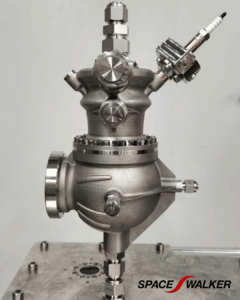Tokyo, Japan, June 06 – Space Walker conducted a combustion test of a stand-alone gas generator, a component of a 10-ton thrust class liquid biomethane engine, at the Shiraoi test site of Muroran Institute of Technology (Muroran City, Hokkaido). The engine under development will contribute to the RaiJin mission of the suborbital spaceplane, which Space Walker aims to launch from Taiki town in Hokkaido, Japan, in 2028.

The gas generator cycle engine under development
Space Walker is developing a gas generator cycle engine, also called an open cycle, to optimize balance between performance and cost. The combustion tests were conducted on the gas generator component, which generates turbine-driven gas as a power source for the turbopump, an important part of the engine that feeds propellant into the combustion chamber. A metal 3D printer manufacturing is used to achieve lightweight and high economic efficiency with a minimum number of parts.
 |
Gas generator EM model made by a 3D printer |
Summary of Gas Generator Standalone Combustion Test
<Ignition Test>
Verify ignition and hard start condition
<Combustion Test>
Acquire important characteristics such as combustion pressure, discharge temperature
Test period:
May 21, 2025 – May 28, 2025 (97 tests in total)
Test site:
Muroran Institute of Technology, Shiraoi Test Site
Burning time:
19 seconds maximum
Division in charge:
Dr. Koichi Yonemoto, CTO, SPACE WALKER
Propulsion team, Space Transportation Division, SPACE WALKER
Test results:
Ignition and combustion characteristics of the gas generator were obtained. Uniformity of combustion gas temperature distribution, which is required for turbine-driven gas, was confirmed.
Cooperating company:
SUIHO SPACE INNOVATIONS Inc.
Main features of Space Walker’s gas generator cycle engine:
● First stage engine for launch vehicles with ignition from the ground
● Environmentally friendly liquid biomethane (LBM) as fuel
● Independent twin-shaft turbo pump to avoid failure mode, where liquid oxygen (LOX) and liquid biomethane (LBM) directly mix
● Health monitoring system to avoid engine shutdown and airframe damage in the event of an anomaly
● Developability for future on-orbit re-ignition
● Superior sealing and leak-proof design
Future Development
Based on the results of this test, Space Walker plans to advance development with a series of rated tests in combination with other engine components, such as the turbo pump stand-alone test.
In parallel, as part of our commitment to strengthen our organization for the development and mass production of spaceplanes and their various components, Space Walker is preparing the Minamisoma Factory—our new development and production base. This transition includes the relocation of our flagship branch to Minamisoma City, Fukushima Prefecture, effective as of May 23rd, 2025. At the plant, we will primarily manufacture and assemble each engine component and conduct various tests, accelerating progress toward our goal of the stand-alone engine combustion test by the end of FY2025.
We look forward to providing further updates as we continue on the technological progress of our space transportation system development.
——————————————
【About SPACE WALKER】
Space Walker is a university startup conducting research and development of winged reusable suborbital and orbital spaceplanes. The company also develops key components and other related businesses, such as next-generation composite tanks—applying space technology to accelerate industrial decarbonization on Earth. Space Walker envisions sustainable space transportation for all, as familiar as commercial air travel today. For more information, please visit https://space-walker.co.jp/en
【For inquiries, contact】
Corporate Planning Office/Public Relations
pr@space-walker.co.jp

